Windsor, Berkshire
| Windsor | |
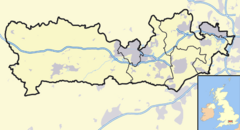 Windsor shown within Berkshire |
|
| Population | 28,324 |
|---|---|
| OS grid reference | |
| Unitary authority | Windsor and Maidenhead |
| Ceremonial county | Berkshire |
| Region | South East |
| Constituent country | England |
| Sovereign state | United Kingdom |
| Post town | WINDSOR |
| Postcode district | SL4 |
| Dialling code | 01753 |
| Police | Thames Valley |
| Fire | Royal Berkshire |
| Ambulance | South Central |
| European Parliament | South East England |
| UK Parliament | Windsor |
| List of places: UK • England • Berkshire | |
Windsor (pronounced /ˈwɪnzə/, /ˈwɪndzə/) is a suburban town and tourist destination in the Royal Borough of Windsor and Maidenhead in Berkshire, England. It is best known as the site of Windsor Castle.
The town is situated 21 miles (34 km) west of Charing Cross. It is immediately south of the River Thames, which forms its boundary with Eton. The village of Old Windsor, just over two miles to the south, predates what is now called Windsor by around 300 years; in the past Windsor was formally referred to as New Windsor to distinguish the two.[1]
Contents[hide] |
History
Windsor is first mentioned in the Anglo-Saxon Chronicle. The name originates from old English Windles-ore, or 'winch by the riverside',[2][3] a royal settlement, now called Old Windsor, located about three miles from the modern town. Some time after 1086, probably in the reign of King Henry I, the royal household relocated three miles up-stream to the recently built timber motte and bailey castle in the manor of Clewer (noted in the Domesday Book as 'Windsor Castle'). By 1110, important crown weddings were noted as taking place at the castle and King Henry married his second wife there in 1121, after the 'White Ship' disaster. The settlement at Old Windsor largely transferred to this 'New' Windsor during the 12th century, although susbstantial planning and setting out of the new town (including the parish church, marketplace, bridge and leper hospital) did not take place until c. 1170, following the civil war of Stephen's reign. At about the same time, the present upper ward of the castle was rebuilt in stone. Windsor bridge is the earliest bridge on the Thames between Staines and Reading, when bridge building was not common. It played an important part in the national road system, and by diverting traffic into the new town, underpinned its success.
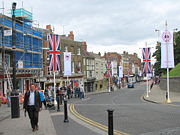
The town of New Windsor, as ancient demesne of the Crown, was a privileged settlement from the start, apparently having the rights of a 'free borough' for which other towns had to pay substantial fees to the king. It had a merchant guild from the early 13th century and, under royal patronage, was made the chief town of the county by late the same century. Windsor was granted royal borough status by Edward I's charter of 1277 which gave no new rights or privileges to Windsor but, as one historian puts it, "recognised [Windsor's] existence and gave it a legal status as a borough".[4]
New Windsor was a nationally significant town in the Middle Ages, certainly one of the fifty wealthiest towns in the country by 1332. Its prosperity came from its close association with the royal household. The repeated investment in the castle brought London merchants (goldsmiths, vintners, spicers and mercers) to the town & provided much employment for townsmen. The development of the castle under Edward III (1350-68), for example, was the largest secular building project in England of the Middle Ages and many Windsor people worked in the castle on this building project. Henry III, a hundred years earlier, spent more on Windsor Castle than any other royal building project, save the rebuilding of Westminster Abbey. The Black Death in 1348, although reducing some town's population by up to 50%, seems to have had less of an impact in Windsor. Possibly 30% of the town's population died, but the building projects of Edward III brought many building workers to the town, possibly doubling the population: the Black Death, and the plagues that followed in 1361 - 72, were a 'boom' time for the local economy. New people came to the town from every part of the country, and from continental Europe, to benefit from royal expenditure at the castle. The poet, Geoffrey Chaucer, worked at Windsor Castle as 'Clerk of the Works' in 1391.
The development of the castle continued in the 15th century. Windsor became a major pilgrimage destination, particularly for Londoners. Pilgrims came to touch the royal shrine of the murdered Henry VI and the fragment of the True Cross in the new St George's Chapel (1480) and visit the same king's college dedicated the Virgin (1440) at Eton (now Eton College). Pilgrims came with substantial sums to spend. There were over twenty-nine inns in Windsor to provide accommodation, some very large. The town became very prosperous. For London pilgrims, Windsor was probably second in importance only to Canterbury and the shrine of Saint Thomas Becket. Henry VIII was buried in St George's (1547), next to the body of Jane Seymour the mother of his only legitimate son, Edward (later Edward VI). Henry, the inventor of the Church of England, may have wanted to benefit from the stream of Catholic pilgrims coming to the town. His will gives that impression.
Tudor and Stuart periods
The town began to stagnate about ten years after the Reformation. The castle was considered old fashioned and shrines to the dead thought 'superstitious'. The early modern period formed a stark contrast to the medieval history of the town. Most accounts of Windsor in the 16th and 17th century talk of its poverty, badly made streets and poor housing. Shakespeare's play The Merry Wives of Windsor is set in Windsor and contains many references to parts of the town and the surrounding countryside. Shakespeare must have walked the town's streets, near the castle and river, much as people still do. The play may have been written in the Garter Inn, although this was certainly not part of the modern Harte and Garter Hotel opposite the castle. Windsor was the home of the New Model Army and the castle was garrisoned by Colonel Venn during the English Civil War. Despite its royal dependence, like many commercial centres, Windsor was a Parliamentarian town. Charles I was buried without ceremony in St George's after his execution at Whitehall in 1649. The present Guildhall, built in 1680, replaced an earlier market hall, that had been built on the same site in c. 1580, as well as the old guildhall, which faced the castle and had been built in c. 1370. The contraction in the number of public buildings speaks of a town in decline.
Georgian and Victorian periods
In 1778, there was a resumption of the royal presence, with George III at the Queen's Lodge and, from 1804, at the castle. This started a period of new development in Windsor, with the building of two army barracks. However, the associated large numbers of soldiers led to a major prostitution problem by 1830 in a town where the number of streets had little changed since 1530. The substantial redevelopment of the castle in the subsequent decade, the coming of two railways in 1849 and Queen Victoria's residence from 1840 signalled the most dramatic changes in the town's history. It was catapulted from a sleepy medieval has-been, to the centre of Empire - many European crowned heads of state came to Windsor to visit the Queen throughout the 19th century. Unfortunately, excessive redevelopment and 'refurbishment' of Windsor's medieval fabric at this time resulted in widespread destruction of the old town, including the slightly earlier pulling down of the old parish church of St John the Baptist in 1820. The original had been built in 1180.
Later periods
The development of the majority of the present streets in the town dates from the mid-19th century.[5] However, the main street, Peascod Street (pronounced Pes-cod Street) is very ancient. It predates the castle by many years, certainly it formed part of the tenth century parish structure in east Berkshire. By this measure, the thousand year old royal castle, although the largest and longest occupied in Europe, is a relatively recent development. The early history of the site on which the town is now built, and for the period before the building of the castle, is unknown, although the site was almost certainly settled. Histories of the town note that the combination of the navigable river and the strategically-placed hill point to the likelihood of continuous human settlement from the earliest times. Evidence includes archaeological finds from Windsor, such as paleolithic hand-axes, neolithic flint picks, Bronze Age swords and an Iron Age brooch. Although Roman remains are few, there is ample evidence of Saxon settlement in the area.[4] "New Windsor" was officially renamed "Windsor" in 1974.
Shopping
Windsor is particularly well served when it comes to shops. As a tourist town there is a wide selection of gift shops around the castle, together with stylish shops and restaurants in Windsor Royal Station as well as an independent department store, W J Daniel, a little way down Peascod Street. Daniels is also noted for its toy department. Additional stores include a Marks & Spencer store in Peascod Street and a new Waitrose supermarket in King Edward Court. There are many other shops within this area, many being famous names normally only expected to be found in London. The new development of shops also includes a Zara, Topshop, New Look and H&M.
Tourism
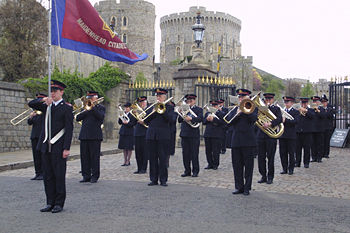
Windsor is a popular tourist destination and location of Windsor Castle, one of the official residences of the British Royal Family. The castle was originally established by King William I of England but has been substantially altered and added to over the centuries.
As a result of the royal residence Windsor has facilities usually found in larger towns: two railway stations, a theatre and several substantial hotels. The town is also the location of Legoland, built on the site of Windsor Safari Park. On construction, several tons of hippo dung had to be removed from the enclosure used by the animals.
Regular return riverboat cruises operate daily from February to November from the Promenade, Barry Avenue. These Trips operated by French Brothers
The Windsor wheel is a more recent addition to the town's tourist attractions, and provides an overhead view of the surrounding area, including the castle, Eton and the Thames Valley. Located in Alexandra Gardens near the River Thames, it is assembled in the summer and dismantled in the autumn.
Transport
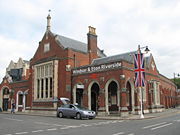
Windsor is accessible from J6 of the M4 and Slough via a 3 mile long dual-carriageway.
Windsor has two railway stations. Windsor & Eton Central railway station has a shuttle service to Slough which has access to trains into London Paddington, or west to Maidenhead and as far as Bristol. Windsor & Eton Riverside station provides a service to London Waterloo. Both stations were built at around the same time in the 19th Century as the two train companies who owned the lines at the time wanted to carry Queen Victoria to Windsor, with the first line opened gaining the privilege. From 1883 to 1885, the London Underground's District Line's westbound service ran to as far as Windsor.
Windsor is linked to the town of Eton (which is situated on the opposite bank of the River Thames) by Windsor Bridge. Originally a fully trafficked road bridge, Windsor Bridge is now for pedestrians and cyclists only and provides an excellent walking route from Windsor to Eton's High Street. To the south of the town lies Windsor Great Park and the towns of Old Windsor, Egham and Virginia Water.
Windsor lies on National Cycle Network Route 4 (London — St David's). The main access roads serving the town have adjacent cycle paths or nearby alternative traffic-free cycle routes.
Notable residents
Other than The Queen and other British Royal Family members, Windsor has many notable residents both former and current.
- Actress Anna Friel spent several years living in Windsor, but moved on in 2007
- Australian pop singer Nathalie Imbruglia owns a house on White Lilies Island in the Clewer Village area of Windsor.
- Actor Michael Caine lived for many years in the Old Mill House at the end of Mill Lane, Windsor. The house was subsequently sold to guitarist Jimmy Page of the rock band Led Zeppelin.
- Swedish entrepreneur Peter Karlsson moved to Windsor
- Actor Kris Marshall is a long time and current resident of Windsor
- Comedian Freddie Starr - Lived in Windsor in the '70s in the famous St Leonards Hill area
- Pop Star Lisa Scott Lee - Recently moved on from the teen band Steps to doing solo work.
- Margaret Oliphant - 19th century novelist and historical writer. Lived at Clarence Crescent. Today the house is named "The Oliphant House".
Politics

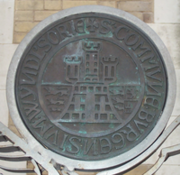
-
For more details on this topic, see Windsor (UK Parliament constituency).
Windsor is part of the Royal Borough of Windsor and Maidenhead which is administered by an elected unitary authority. The mayor is Councillor Leo Walters (Conservative, though is politically neutral in the role).
The current MP for the Windsor constituency (which includes surrounding small towns and villages, such as Eton and Datchet) is Adam Afriyie (Conservative), who was elected at the 2005 General Election. Afriyie is notable for being the first black Conservative MP.
References
- ↑ Local government legislation in the 1970s referred to the borough as "New Windsor".
- ↑ The Online Etymology Dictionary
- ↑ A Brief History of Windsor
- ↑ 4.0 4.1 South S.R., The Book of Windsor, Barracuda Books, 1977. ISBN 0-86023-038-4
- ↑ Windsor: a history and description of the castle and the town. John Stoughton, 1862. London: Ward and Co. (pp. 176-177)
External links
- Windsor and Eton travel guide from Wikitravel
- WindsorOnline Guide to Windsor and Eton
- Royal Windsor Website - An ever growing Reference Area for Windsor Past and Present
- Windsor local information website
- Royal Borough of Windsor and Maidenhead website
- Twenty images of Windsor with descriptions on a guided walk
- Windsor site of one of the local newspapers
- ThamesWeb Windsor website
- Royal Berkshire History: Windsor
- A Few Views of Windsor in Old Postcards
- Windsor Arts Centre
- Windsor Festival
- Windsor Town Information and full accommodation guide
- Image gallery for Windsor and its castle.
|
|||||||||||